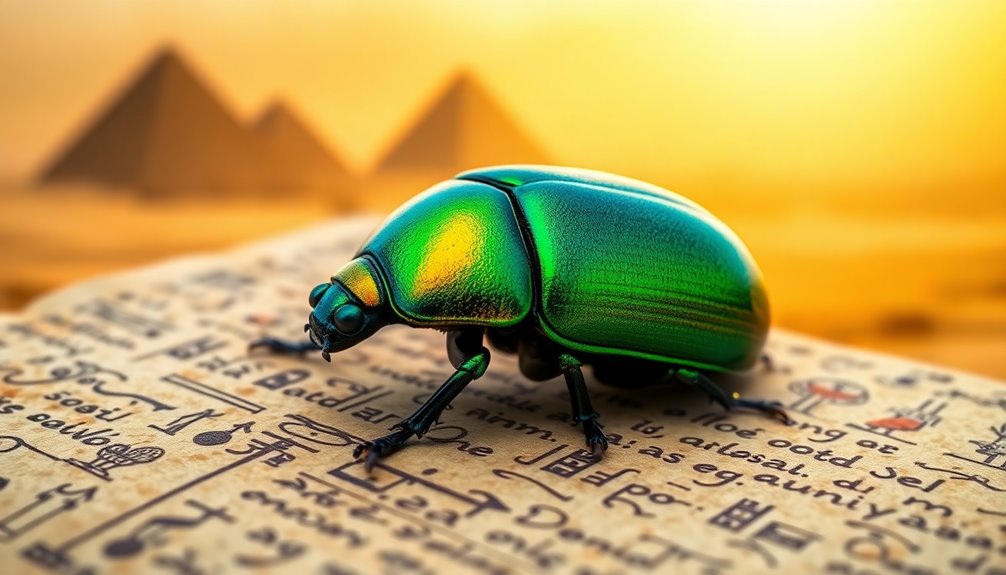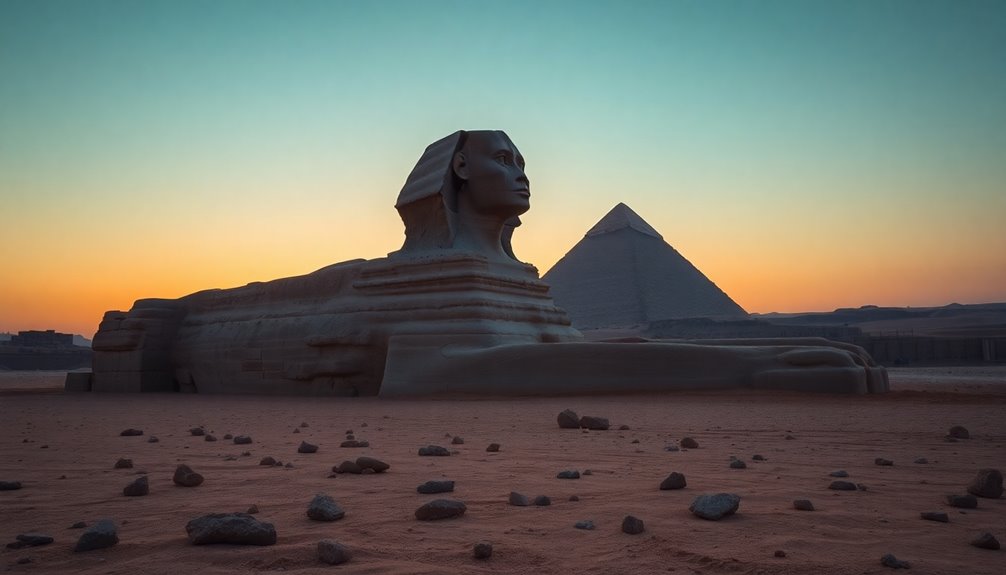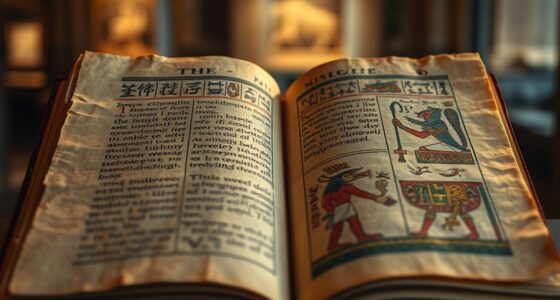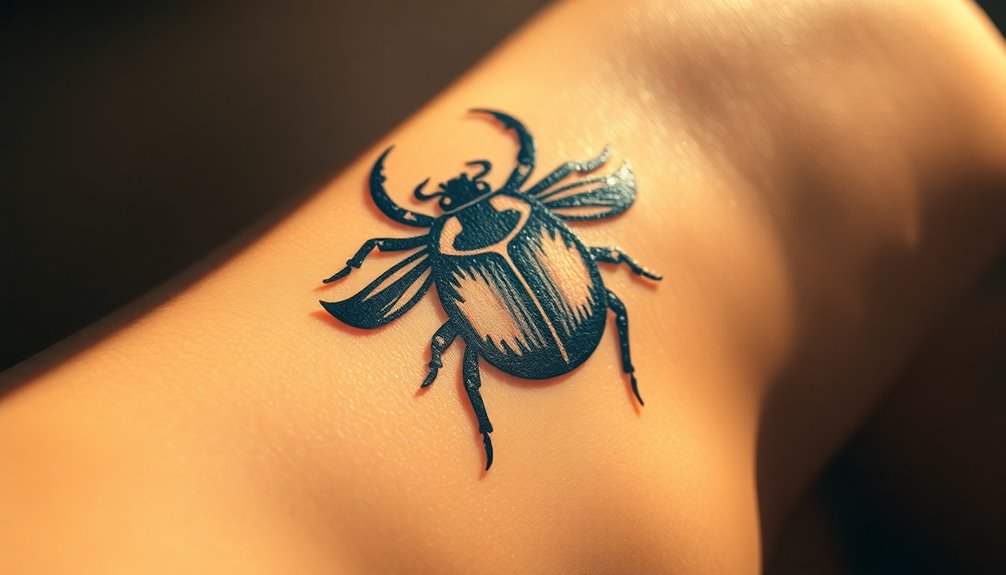Egyptian beetles, especially scarabs, weren't just insects; they were powerful symbols in ancient culture. You'd find them representing life, death, and rebirth, closely linked to the sun god Ra. Scarabs were often placed in tombs, ensuring protection and good fortune in the afterlife. These beetles even rolled dung, reflecting cosmic order and regeneration, which captivated the ancients. Artifacts like heart scarabs were essential in mummification, while scarab motifs adorned jewelry and tomb decorations. Their significance extends to modern designs, keeping ancient beliefs alive. Discover how scarabs influence culture and ecology even today.
Key Takeaways
- Scarab beetles symbolized life, death, and rebirth in Ancient Egypt, closely associated with the sun god Ra and the concept of resurrection.
- Heart scarabs were placed on mummies to protect the soul's journey in the afterlife, signifying their importance in funerary rituals.
- Scarabs served as seals for documents, representing power and authority within administrative practices in ancient Egyptian society.
- Their dung burial behavior contributed to ecological balance by enriching soil fertility and supporting biodiversity, showcasing their vital environmental role.
- Scarab motifs continue to influence modern art and jewelry, reflecting themes of protection and transformation rooted in ancient beliefs.
Historical Significance of Scarabs

Have you ever wondered why scarabs held such a prominent place in Ancient Egyptian culture? The scarab beetle, particularly *Scarabaeus sacer*, was revered for its unique behavior of rolling dung balls, which symbolized the cyclical nature of life, death, and rebirth. This connection to the natural cycle resonated deeply within Egyptian religion, where scarabs became powerful symbols of creation and resurrection.
You'd often find sacred scarabs represented as amulets, believed to provide protection and bring good fortune. They were traded widely throughout the Mediterranean, highlighting their cultural significance. Scarabs were also closely associated with the sun god Ra and the deity Khepri, embodying the daily rebirth of the sun, a core belief in Egyptian spirituality.
Their importance extended beyond amulets; scarabs frequently appeared in tombs and burial artifacts, underscoring their role in the passage into the afterlife. Heart scarabs, in particular, were placed on mummies during mummification, symbolizing the soul's journey after death.
Additionally, scarabs served as seals for documents, representing power and authority, which showcases their widespread significance in both religious and administrative practices of Ancient Egypt.
Symbolism in Ancient Culture
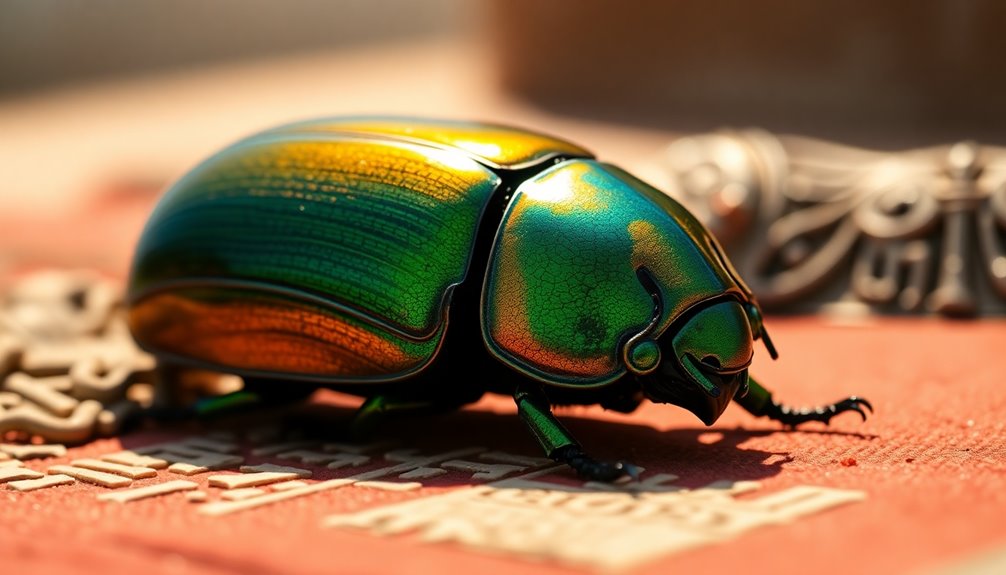
In ancient Egypt, the scarab beetle was more than just an insect; it was a sacred symbol of creation and rebirth.
You'll find that these beetles represented not only the life cycle but also provided protection for the deceased on their journey to the afterlife.
Sacred Connections to Creation
The scarab beetle, a powerful symbol in ancient Egyptian culture, embodies the sacred connections to creation and rebirth. Revered as a creature of regeneration, the scarab, particularly *Scarabaeus sacer*, mirrors the life cycle of the sun. The ancient Egyptians believed that this beetle rolled dung like the sun god Khepri rolled the sun across the sky, symbolizing the daily renewal of life.
In this context, the scarab represented not just physical rebirth but also spiritual transformation. You'd find scarab amulets placed in tombs and on mummies' hearts, ensuring safe passage to the afterlife and protection against evil forces.
The imagery of scarabs in ancient art often depicts them holding the sun in their front legs, reinforcing their divine connection to both creation and the eternal cycle of life and death.
Moreover, the scarab's behavior of rolling dung was seen as a reflection of the cosmic order, further solidifying its status as a sacred creature. Through these symbols and practices, the ancient Egyptians expressed their deep reverence for the scarab, intertwining it with their beliefs about existence, divinity, and the fundamental forces of nature.
Emblems of Rebirth and Protection
Scarabs stand out as powerful emblems of rebirth and protection in ancient Egyptian culture, enchanting anyone who explores their significance. These scarab beetles were deeply woven into the fabric of life and death, symbolizing the cyclical nature of existence.
Here's how they played a crucial role:
- Symbol of Rebirth: The dung beetle, *Scarabaeus sacer*, represented regeneration, mirroring the sun god Khepri's daily resurrection with the rising sun.
- Funerary Practices: Scarab amulets were placed in tombs, ensuring safe passage to the afterlife, reflecting beliefs about resurrection and life beyond death.
- Heart Protection: The heart scarab, often inscribed with protective spells, safeguarded the heart of mummies, underscoring its significance in afterlife protection.
- Authority Symbols: Scarabs served as seals for important documents, symbolizing authority and reinforcing their protective connotations in both personal and political domains.
Through these facets, scarab beetles embodied the ancient Egyptians' profound beliefs in rebirth and protection, making them enduring symbols of life's perpetual cycle.
Their legacy continues to captivate those intrigued by ancient cultures.
Iconic Scarab Artifacts
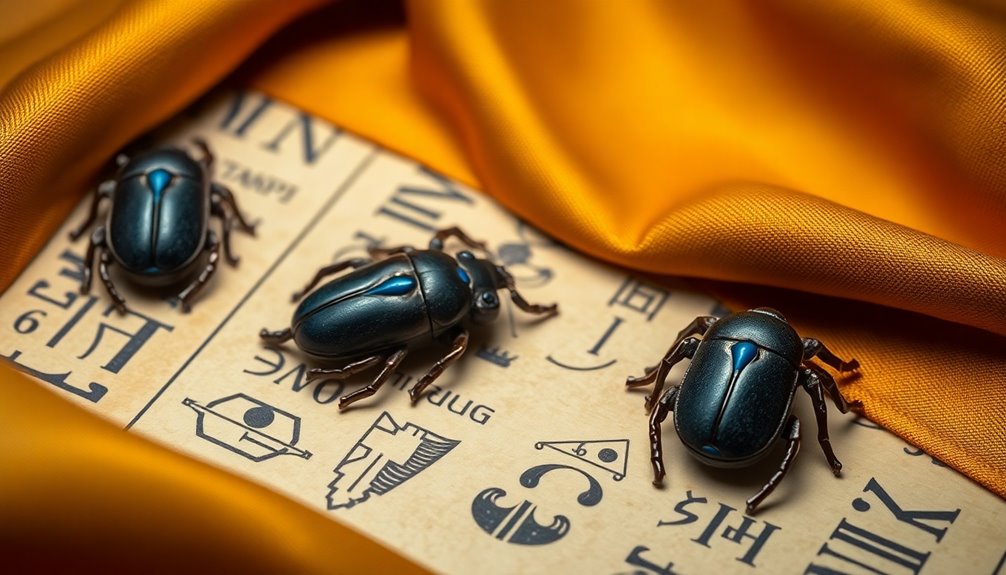
While exploring ancient Egyptian artifacts, you can't overlook the iconic scarab, a symbol of rebirth and protection deeply woven into the culture. These artifacts, often crafted from precious materials, hold significant meaning and showcase the artistry of the time.
Take, for instance, the Scarab of Hatshepsut, a stunning gold piece adorned with jewels that reflects the wealth of the powerful female pharaoh.
Scarab artifacts weren't just decorative; they served essential roles in ancient Egyptian society. Many were placed in tombs as amulets, believed to bring good fortune and safeguard the deceased in the afterlife.
Heart scarabs were particularly important, designed to rest on the chest during mummification, inscribed with protective spells for a safe passage.
Additionally, funerary scarabs featured inscriptions meant to protect the dead, emphasizing their pivotal role in burial rituals. During the Middle Kingdom, these scarabs became mass-produced, serving as seals for legal documents, marking authenticity and authority.
This duality of function, as both spiritual and practical symbols, illustrates the profound impact the dung beetle, represented by the scarab, had on ancient Egyptian life and beliefs.
Funerary Practices and Beliefs
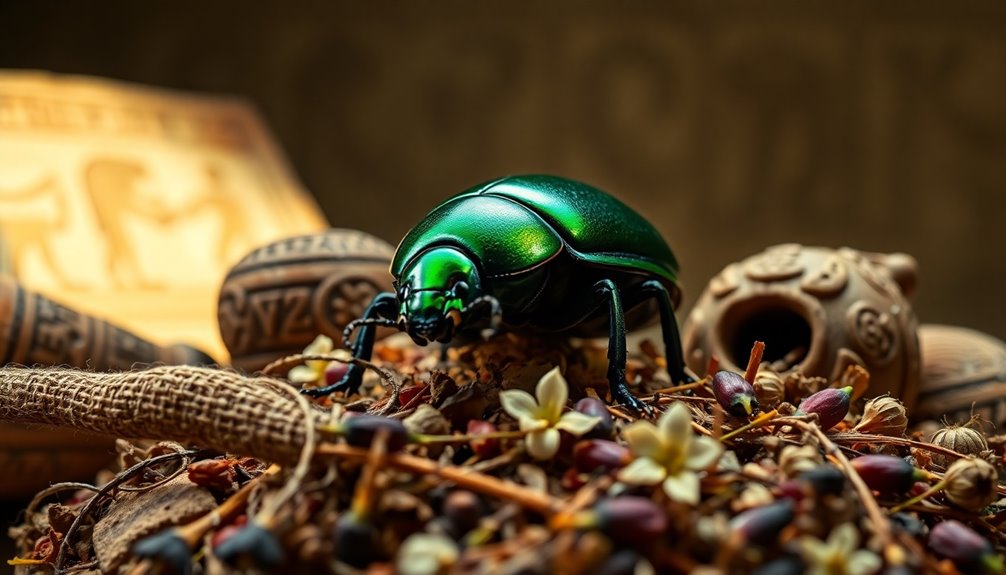
In ancient Egypt, funerary practices were intricately tied to beliefs about the afterlife, with scarab amulets playing an essential role in these rituals. Funerary scarabs, especially heart scarabs, were placed on the chest of mummies to symbolize protection and guarantee safe passage to the afterlife.
These amulets not only featured intricate designs but also often included inscriptions and protective spells aimed at safeguarding the deceased from malevolent forces during their journey.
Here's how scarabs contributed to funerary practices:
- Symbol of Resurrection: Scarabs represented rebirth and eternal life, reflecting the belief in regeneration.
- Mummification Rituals: They were significant in mummification, offering protection to the heart, considered the center of the soul.
- Cultural Significance: Including scarabs in tombs highlighted their importance, symbolizing hope for a safe passage.
- Afterlife Safeguards: The protective spells inscribed on these scarabs aimed to shield the deceased from dangers in the afterlife.
Types of Scarabs and Their Uses
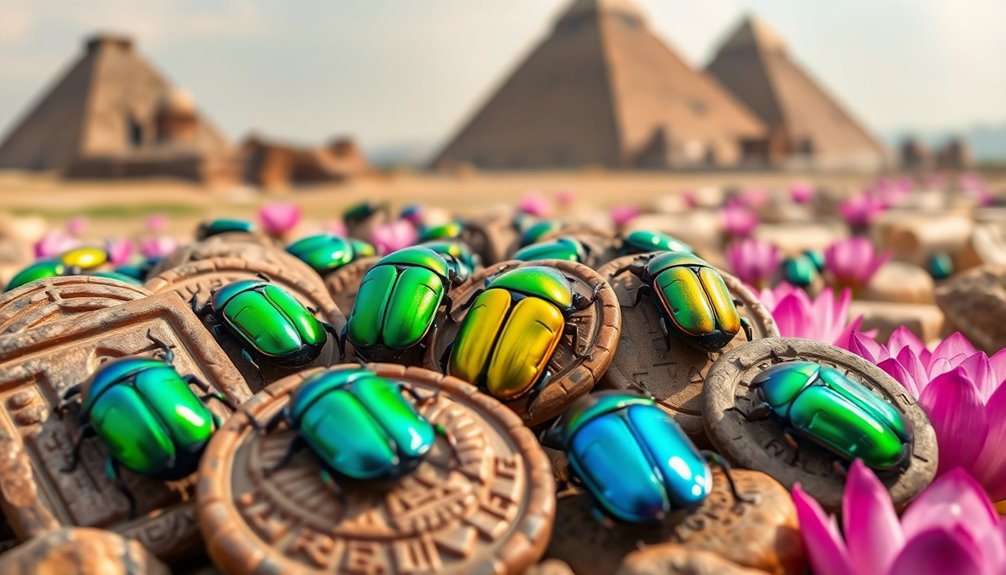
Various types of scarabs played essential roles in ancient Egyptian society, each serving distinct purposes that reflected cultural beliefs and practices. One of the most significant was the Heart Scarab, placed on the chest of mummies during mummification. These scarabs contained protective spells to guarantee the deceased's safe passage into the afterlife.
Additionally, Funerary Scarabs featured intricate inscriptions and were integral to burial rituals, symbolizing protection for the deceased during their journey.
Amuletic Scarabs were popular personal charms worn by individuals seeking protection from harm. Often inscribed with spells, these amulets provided a sense of security in daily life.
Royal Commemorative Scarabs were another type commissioned by Pharaohs to celebrate significant achievements, showcasing elaborate designs and inscriptions that honored their legacy.
Lastly, Administrative Scarabs served a practical purpose, acting as seals for legal documents. These scarabs marked authenticity and authority in ancient Egyptian governance, highlighting their multifaceted roles.
Each type of scarab, whether funerary, amuletic, or administrative, reflects the rich tapestry of ancient Egyptian culture and its deep-seated beliefs in protection and legacy.
Ecological Role of Scarab Beetles
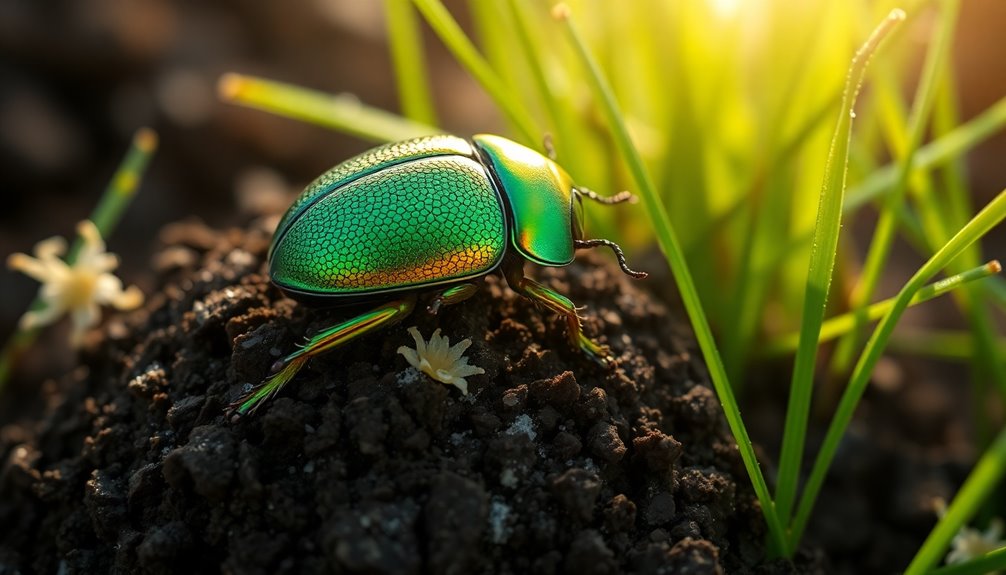
Scarab beetles, especially dung beetles, are fundamental for maintaining the health of ecosystems. Their ecological role is indispensable, particularly when it comes to nutrient cycling and promoting soil health. Here's how they contribute:
- Nutrient Recycling: Scarabaeus sacer and other dung beetles break down animal waste, returning important nutrients to the soil, enhancing fertility.
- Soil Aeration: As they roll and bury dung, they aerate the soil, allowing for better water infiltration and root growth.
- Pest Control: By decomposing waste, they help reduce the presence of harmful pathogens and parasites that could otherwise thrive in decaying matter.
- Biodiversity Support: Their activities promote a balanced ecosystem by providing a habitat for other organisms and ensuring the health of various plant species.
In ancient Egypt, these beetles thrived in warm climates rich in dung, showcasing their adaptability and significance in desert ecosystems.
As you consider the role of scarab beetles today, remember that conservation efforts targeting these incredible insects are fundamental for preserving biodiversity and ensuring the continued ecological functions they provide in various habitats.
Artistic Representations and Influence
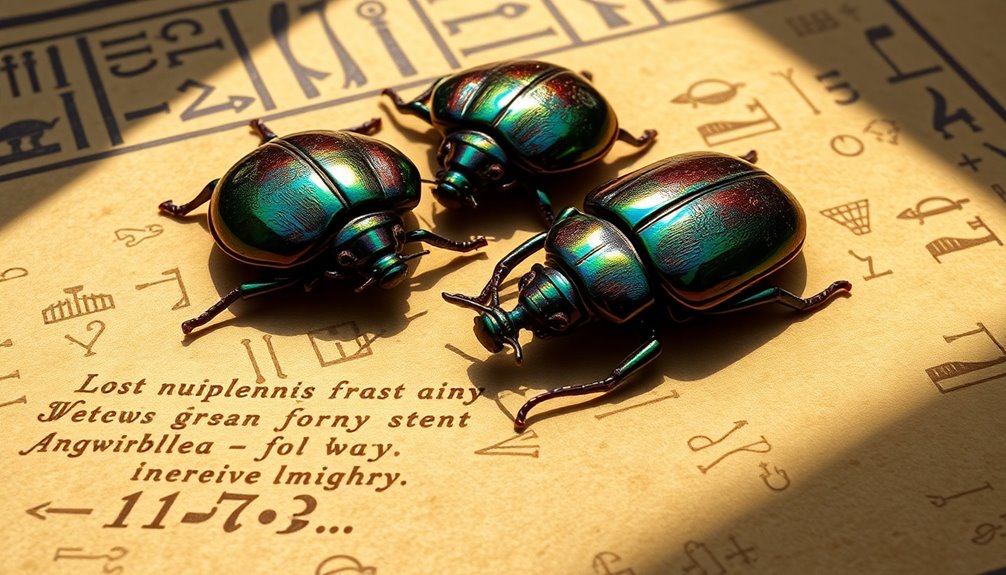
Ancient Egyptian art vividly illustrates the cultural significance of scarab beetles, particularly *Scarabaeus sacer*. These beetles symbolize rebirth and transformation, often depicted holding the sun disk in their legs to represent the sun god Khepri's role in creation.
You'll find artistic representations of scarabs in jewelry, sculptures, and amulets, which served not just as decorative pieces but also as protective symbols believed to bring good fortune.
The advanced craftsmanship of ancient Egyptian artisans shines through in these intricately carved scarabs, made from gold, semi-precious stones, and ivory. Such artistry reflects a deep reverence for these beetles and their symbolism.
In tombs and funerary artifacts, scarabs frequently appear as motifs, reinforcing their connection to themes of immortality and protection against evil, ensuring safe passage to the afterlife for the deceased.
Moreover, the pairing of scarabs with elements like water lilies in Egyptian art highlights a meticulous attention to detail and the spiritual significance embedded in these representations.
This artistic influence underscores how deeply ingrained the scarab beetle was in the culture, showcasing its role in both daily life and the afterlife.
Modern Interpretations of Scarabs
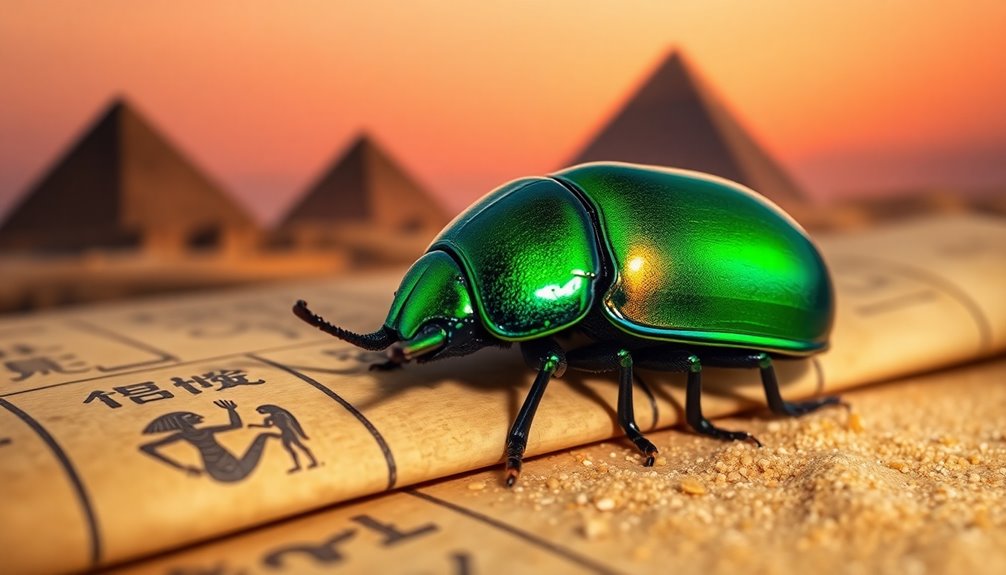
When you look at modern art and jewelry, you can't help but notice the vibrant scarab motifs that echo ancient symbolism.
Designers draw inspiration from these beetles, blending their historical significance with contemporary aesthetics.
This cultural revival not only highlights the scarab's enduring popularity but also its role as a symbol of transformation and luck in today's world.
Symbolism in Contemporary Art
In contemporary art, the symbolism of scarabs resonates deeply, bridging the past with the present through vibrant reinterpretations. Artists today embrace scarab motifs to reflect ancient beliefs about rebirth, transformation, and protection.
You can see this influence in various forms:
- Sculptures and Installations: Many modern artists emphasize life cycles and nature, highlighting the ecological role of dung beetles.
- Fashion Design: Scarab imagery adorns garments and accessories, infusing them with cultural significance and a sense of mystique.
- Tattoo Art: Contemporary tattoos frequently feature scarabs, symbolizing protection and good fortune, connecting wearers to powerful ancient meanings.
- Jewelry: Scarab-inspired pieces reinterpret traditional designs, allowing people to express their connection to cultural heritage.
Additionally, the use of natural materials in modern art often reflects traditional craftsmanship similar to that found in Balinese design. These modern interpretations of scarabs not only celebrate their historical roots but also invite you to explore themes of life, continuity, and the interconnectedness of existence.
Jewelry Design Inspirations
Jewelry design inspired by scarabs captures the imagination, blending history with modern elegance. The scarab beetle, a symbol of rebirth and protection, has become a favorite motif for contemporary designers. By incorporating intricate carvings and gemstone inlays, they evoke the luxurious artistry of ancient Egyptian artifacts.
You'll find that scarab-themed pieces often feature stylized interpretations, enhancing their aesthetic appeal while retaining historical significance.
Many modern jewelry designs highlight the scarab beetle as a symbol of good luck, mirroring its importance in ancient Egyptian culture. Materials like gold, silver, and semi-precious stones reflect the craftsmanship seen in past eras, ensuring that each piece resonates with both historical depth and contemporary style.
Additionally, designers often pair scarab motifs with hieroglyphics or other Egyptian symbols, creating a striking fusion of ancient and modern elements. This unique blend makes scarab-inspired jewelry not just fashionable, but also a meaningful connection to the past.
As you explore these designs, you'll appreciate how they serve as a bridge between ancient traditions and today's styles, appealing to history lovers and fashion enthusiasts alike.
Cultural Revival and Popularity
As modern society embraces its fascination with ancient cultures, the scarab beetle has surged in popularity, symbolizing protection and good fortune. This resurgence highlights the cultural significance of scarabs, originally cherished by ancient Egyptians.
Today, you can see scarab motifs woven into the fabric of contemporary life, influencing various aspects of design and art.
Here are some ways scarabs are celebrated in modern culture:
- Jewelry: Scarab designs adorn rings, necklaces, and bracelets, connecting wearers to ancient beliefs.
- Home Décor: Scarab-inspired art pieces and decorative items infuse homes with a touch of history and elegance.
- Fashion: Designers incorporate scarab patterns into clothing, making bold statements that link past and present.
- Literature and Film: The scarab continues to symbolize mystery and ancient wisdom, appearing frequently in stories and cinematic adventures.
Museums and archaeological sites in Egypt further promote awareness of scarabs, showcasing their historical importance while enhancing their appeal as cultural artifacts.
This revival not only enriches modern design but also keeps the legacy of the scarab alive for future generations.
Scarabs in Egyptian Tourism
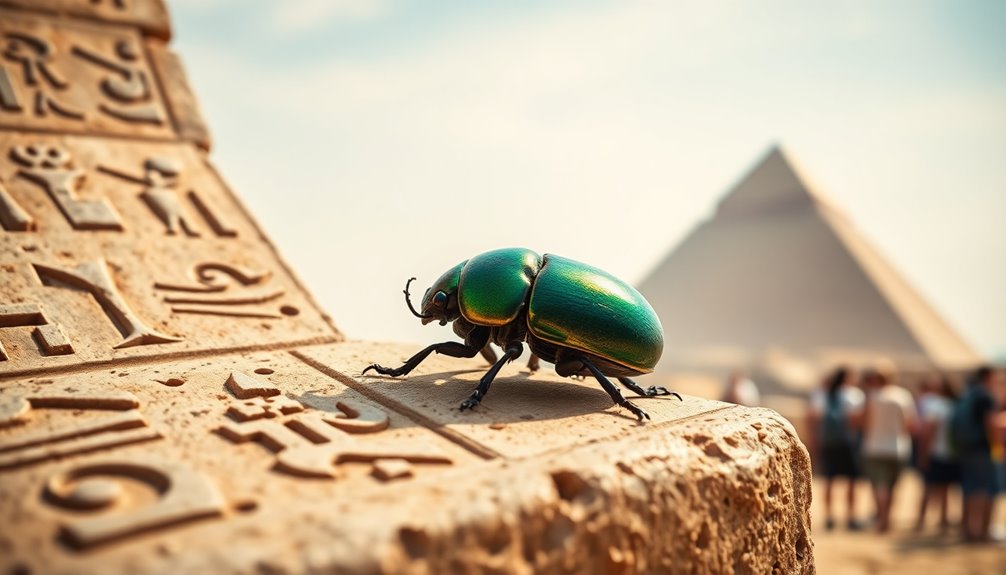
Scarabs captivate tourists in Egypt, serving as powerful symbols of protection and good fortune. As you explore the bustling markets and archaeological sites, you'll find that scarabs are highly sought-after souvenirs, often crafted into stunning jewelry and decorative items.
Major attractions, like the Valley of the Kings and the Egyptian Museum in Cairo, showcase numerous scarab artifacts, giving you a glimpse into their cultural significance in ancient Egyptian society.
While on guided tours, you'll likely hear fascinating discussions about scarabs' roles in funerary practices. These sacred beetles were used as amulets, believed to guarantee safe passage to the afterlife. This educational aspect enhances your experience, connecting you to the beliefs and traditions of ancient Egyptians.
You'll also notice scarab motifs in various forms of ancient art, such as wall paintings and sculptures, highlighting the intricate craftsmanship of those artisans. Scarab-themed attractions and exhibitions let you engage with the historical narratives surrounding these revered creatures, deepening your appreciation for their impact on ancient Egyptian beliefs.
Whether as souvenirs or symbols of protection, scarabs remain an integral part of your Egyptian adventure.
Conservation Efforts for Scarabs
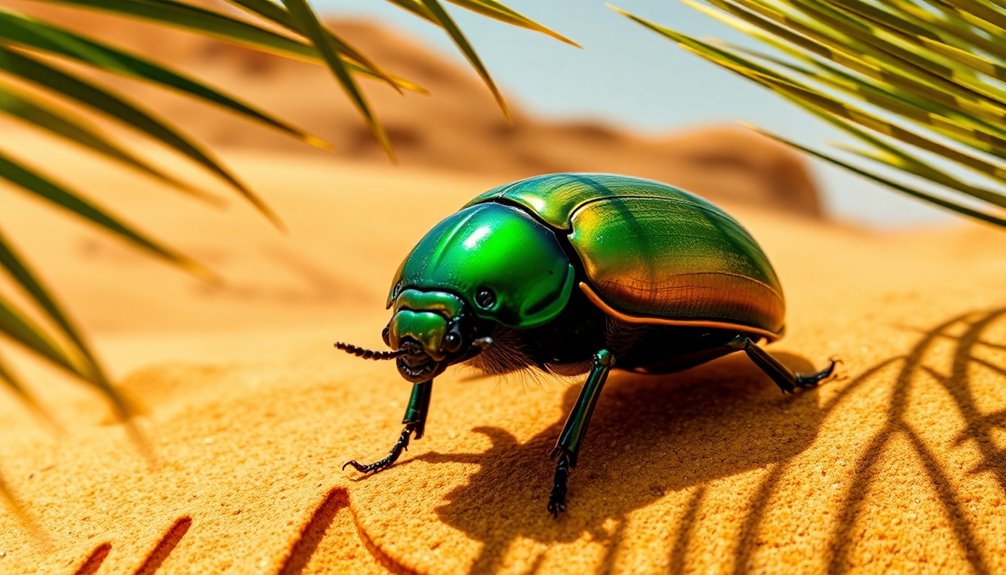
While exploring the rich cultural tapestry of ancient Egypt, you'll come to appreciate the importance of conservation efforts for scarabs.
These remarkable beetles are crucial for nutrient recycling and soil aeration, but they face significant threats from habitat destruction and agricultural practices.
To safeguard these essential creatures, various initiatives have emerged, focusing on sustainable land use and ecosystem protection.
Here's how conservation efforts are making a difference:
- Preserving Habitats: Efforts target warm climates where dung is abundant to guarantee scarabs thrive.
- Educating Communities: Local populations learn about the ecological importance of scarabs, fostering protective practices.
- Research Initiatives: Studies on scarab populations enhance our understanding of their ecological roles, contributing to biodiversity.
- International Collaboration: Countries are joining forces to protect scarab species, recognizing their cultural significance and ecological contributions.
Frequently Asked Questions
What Was the Significance of the Beetle in Ancient Egypt?
In ancient Egypt, the beetle held immense significance, symbolizing rebirth and regeneration.
You'd see it represented in art and jewelry, reflecting its connection to the sun god Khepri. People believed that beetles had protective qualities, often placing scarab amulets in tombs to guarantee safe passage to the afterlife.
The craftsmanship of these artifacts showcased their cultural importance, as they served not only as symbols of power but also as personal protectors for the living.
Are the Scarabs From the Mummy Real?
When you think about the treasures of ancient tombs, the scarabs stand out like stars in a night sky.
Yes, the scarabs found with mummies are indeed real. Crafted from various materials, these beetles were more than just decorative items; they symbolized protection and rebirth.
Often inscribed with spells, they were placed strategically to guarantee safe passage for the deceased into the afterlife, reflecting the deep spiritual beliefs of ancient Egyptians.
What Is the Secret Beetle in Egypt?
The secret beetle in Egypt refers to the sacred scarab, known as *Scarabaeus sacer*.
You'll find it revered for its unique role in nature, particularly in rolling dung, which symbolizes life, death, and rebirth.
This beetle's connection to the sun god Khepri highlights its significance in creation and renewal.
Scarabs also appear in funerary practices and serve as powerful amulets, symbolizing protection and transformation, showcasing their importance in ancient Egyptian culture.
Which Beetles Were Considered Sacred in Ancient Egypt?
In ancient Egypt, the dung beetle, or *Scarabaeus sacer*, was revered like a divine deity, symbolizing life's eternal cycle.
You'd find these sacred beetles associated with the sun god Khepri, embodying rebirth and creation. Scarabs adorned amulets and were placed in tombs, ensuring safe passage to the afterlife.
Their unique behavior of rolling dung was seen as a powerful metaphor for the sun's journey, solidifying their importance in Egyptian culture and symbolism.
Conclusion
In summary, scarabs were like the heartbeat of ancient Egyptian culture, symbolizing rebirth and protection. Their significance stretched beyond mere decoration; they played vital roles in funerary practices and daily life. Today, as you explore Egyptian history, you'll find that the legacy of these remarkable beetles still resonates. By appreciating their impact, you connect with a rich tapestry of beliefs and traditions that shaped a civilization, reminding us of the enduring power of nature in our lives.

